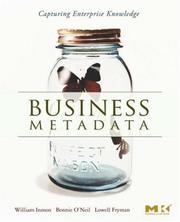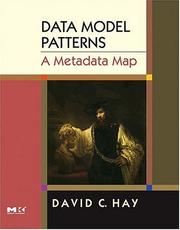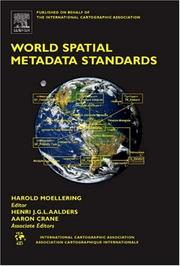| Listing 1 - 10 of 35 | << page >> |
Sort by
|
Book
ISBN: 1280349972 9786610349975 0764571591 Year: 2004 Publisher: Indianapolis, Ind. : Wiley,
Abstract | Keywords | Export | Availability | Bookmark
 Loading...
Loading...Choose an application
- Reference Manager
- EndNote
- RefWorks (Direct export to RefWorks)
The heart of the book provides the complete set of models that will support most of an organization's core business functions, including universal meta models for enterprise-wide systems, business meta data and data stewardship, portfolio management, business rules, and XML, messaging, and transactionsDevelopers can directly adapt these models to their own businesses, saving countless hours of development timeBuilding effective meta data repositories is complicated and time-consuming, and few IT departments have the necessary expertise to do it right-which is why this book is s

ISBN: 9780123737267 0123737265 9780080552200 008055220X 1281046574 9781281046574 9786611046576 6611046577 Year: 2008 Publisher: Amsterdam ; Boston : Elsevier/Morgan Kaufmann,
Abstract | Keywords | Export | Availability | Bookmark
 Loading...
Loading...Choose an application
- Reference Manager
- EndNote
- RefWorks (Direct export to RefWorks)
People have a hard time communicating, and also have a hard time finding business knowledge in the environment. With the sophistication of search technologies like Google, business people expect to be able to get their questions answered about the business just like you can do an internet search. The truth is, knowledge management is primitive today, and it is due to the fact that we have poor business metadata management. This book is about all the groundwork necessary for IT to really support the business properly. By providing not just data, but the context behind the data. For th
Database management. --- Metadata. --- Management information systems.
Book
ISBN: 9781509538935 1509538933 9781509538942 1509538941 150953895X 1509539204 Year: 2019 Publisher: Cambridge, U.K.: Polity,
Abstract | Keywords | Export | Availability | Bookmark
 Loading...
Loading...Choose an application
- Reference Manager
- EndNote
- RefWorks (Direct export to RefWorks)
"Theory of the Hashtag traces the young and spectacular career of the humble hashtag, shining a bright light on a small but pervasive feature of our contemporary digital culture and shows how it is surreptitiously shaping the public sphere. It is a short book about the most prominent sign of our times"--
Hashtags (Metadata) --- Social media --- User-generated media --- Communication --- User-generated content --- Metadata --- #SBIB:309H503 --- Semiotiek, semiologie --- Social media.

ISBN: 9780120887989 0120887983 1281050334 0080477038 9780080477039 9781281050335 Year: 2006 Publisher: Amsterdam ; Boston : Elsevier Morgan Kaufmann,
Abstract | Keywords | Export | Availability | Bookmark
 Loading...
Loading...Choose an application
- Reference Manager
- EndNote
- RefWorks (Direct export to RefWorks)
In recent years, companies and government agencies have come to realize that the data they use represent a significant corporate resource, whose cost calls for management every bit as rigorous as the management of human resources, money, and capital equipment. With this realization has come recognition of the importance to integrate the data that has traditionally only been available from disparate sources. An important component of this integration is the management of the "metadata? that describe, catalogue, and provide access to the various forms of underlying business data. The "me
Data warehousing --- Metadata --- Data warehousing. --- Metadata. --- Data about data --- Meta-data --- Information organization --- Information warehousing --- Warehousing, Data --- Database management --- Management information systems --- Multidimensional databases
Book
ISBN: 1780633955 1843347296 9781780633954 1306176840 9781306176842 9781843347293 9781843347293 Year: 2013 Publisher: Oxford : Chandos Publishing,
Abstract | Keywords | Export | Availability | Bookmark
 Loading...
Loading...Choose an application
- Reference Manager
- EndNote
- RefWorks (Direct export to RefWorks)
Cultural heritage professionals have high levels of training in metadata. However, the institutions in which they practice often depend on support staff, volunteers, and students in order to function. With limited time and funding for training in metadata creation for digital collections, there are often many questions about metadata without a reliable, direct source for answers. The Metadata Manual provides such a resource, answering basic metadata questions that may appear, and exploring metadata from a beginner's perspective. This title covers metadata basics, XML basics, Dublin Core, VRA C
Business -- Data processing. --- Database management. --- Metadata. --- Social Sciences --- Library & Information Science --- Libraries and museums. --- Museums and libraries --- Museums --- Museum libraries --- Data about data --- Meta-data --- Information organization --- Metadata

ISBN: 0080457614 9780080457611 1280630086 9781280630088 9786610630080 6610630089 9780080439495 0080439497 Year: 2005 Publisher: Amsterdam ; San Diego, CA ; Oxford : Elsevier,
Abstract | Keywords | Export | Availability | Bookmark
 Loading...
Loading...Choose an application
- Reference Manager
- EndNote
- RefWorks (Direct export to RefWorks)
This book represents years of work by the ICA Spatial Data Standards Commission during the 1995-2003 ICA cycles. It consists of an Introduction and six Regional Summary chapters that describe the spatial metadata activities happening in Europe, North America, Asia/Pacific, Latin America, Africa/Middle East, and the ISO community. These chapters provide the broader context and description of the milieu in which these standards operate, so that the reader can more easily understand the scientific and technical framework from whence a particular standard has emerged. The third section
Information storage and retrieval systems --- Geographic information systems --- Metadata. --- Geography --- Standards.
Book
ISBN: 1501344307 1501344293 1501344285 Year: 2019 Publisher: London : Bloomsbury Publishing,
Abstract | Keywords | Export | Availability | Bookmark
 Loading...
Loading...Choose an application
- Reference Manager
- EndNote
- RefWorks (Direct export to RefWorks)
"Celebration and criticism of so-called "hashtag activism" rarely addresses the hashtag itself as an artifact or tries to locate its place in the history of reading and writing for machines. Although hashtags tend to be associated with Silicon Valley invention myths or power users like celebrities, the hashtag is actually the result of accreted sets of practices and invisible labor involving negotiating competing claims about identity, ownership, and naming conventions. Thus the hashtag is part of the longer history of metadata that has involved cataloging and classifying objects throughout human history. However, high-tech machine learning algorithms are changing this traditional process of collective meaning making in which content is sorted into groups to be more easily findable, and perhaps computational agents will one day apply metadata to data in ways that exclude human decision-making entirely."
Hashtags (Metadata) --- Social media. --- New Media and Technology --- Literary Theory --- Literary Studies --- Material Culture
Book
ISBN: 9781638352631 1638352631 Year: 2012 Publisher: Shelter Island : Manning Publications, 2014,
Abstract | Keywords | Export | Availability | Bookmark
 Loading...
Loading...Choose an application
- Reference Manager
- EndNote
- RefWorks (Direct export to RefWorks)
Summary Tika in Action is a hands-on guide to content mining with Apache Tika. The book's many examples and case studies offer real-world experience from domains ranging from search engines to digital asset management and scientific data processing. About the Technology Tika is an Apache toolkit that has built into it everything you and your app need to know about file formats. Using Tika, your applications can discover and extract content from digital documents in almost any format, including exotic ones. About this Book Tika in Action is the ultimate guide to content mining using Apache Tika. You'll learn how to pull usable information from otherwise inaccessible sources, including internet media and file archives. This example-rich book teaches you to build and extend applications based on real-world experience with search engines, digital asset management, and scientific data processing. In addition to architectural overviews, you'll find detailed chapters on features like metadata extraction, automatic language detection, and custom parser development. This book is written for developers who are new to both Scala and Lift and covers just enough Scala to get you started. What's Inside Crack MS Word, PDF, HTML, and ZIP Integrate with search engines, CMS, and other data sources Learn through experimentation Many examples This book requires no previous knowledge of Tika or text mining techniques. It assumes a working knowledge of Java. ========================================?== Table of Contents PART 1 GETTING STARTED The case for the digital Babel fish Getting started with Tika The information landscape PART 2 TIKA IN DETAIL Document type detection Content extraction Understanding metadata Language detection What's in a file? PART 3 INTEGRATION AND ADVANCED USE The big picture Tika and the Lucene search stack Extending Tika PART 4 CASE STUDIES Powering NASA science data systems Content management with Apache Jackrabbit Curating cancer research data with Tika The classic search engine example
Open source software. --- Data mining. --- Metadata. --- Apache (Computer file : Apache Group) --- Apache Tika.
Book
ISBN: 0262331209 0262331195 9780262528511 9780262331197 9780262331203 0262528517 Year: 2015 Publisher: Cambridge, Massachusetts ; London, England : The MIT Press,
Abstract | Keywords | Export | Availability | Bookmark
 Loading...
Loading...Choose an application
- Reference Manager
- EndNote
- RefWorks (Direct export to RefWorks)
"When "metadata" became breaking news, appearing in stories about surveillance by the National Security Agency, many members of the public encountered this once-obscure term from information science for the first time. Should people be reassured that the NSA was "only" collecting metadata about phone calls -- information about the caller, the recipient, the time, the duration, the location -- and not recordings of the conversations themselves? Or does phone call metadata reveal more than it seems? In this book, Jeffrey Pomerantz offers an accessible and concise introduction to metadata. In the era of ubiquitous computing, metadata has become infrastructural, like the electrical grid or the highway system. We interact with it or generate it every day. It is not, Pomerantz tell us, just "data about data." It is a means by which the complexity of an object is represented in a simpler form. For example, the title, the author, and the cover art are metadata about a book. When metadata does its job well, it fades into the background; everyone (except perhaps the NSA) takes it for granted. Pomerantz explains what metadata is, and why it exists. He distinguishes among different types of metadata -- descriptive, administrative, structural, preservation, and use -- and examines different users and uses of each type. He discusses the technologies that make modern metadata possible, and he speculates about metadata's future. By the end of the book, readers will see metadata everywhere. Because, Pomerantz warns us, it's metadata's world, and we are just living in it"--
Metadata. --- Information organization. --- Information storage and retrieval --- Organization of information --- Information science --- Information storage and retrieval systems --- Data about data --- Meta-data --- Information organization --- Metadata --- E-books --- INFORMATION SCIENCE/General --- COMPUTER SCIENCE/General
Book
ISBN: 9780128053416 0128053410 9780128045138 0128045132 Year: 2016 Publisher: Amsterdam, Netherlands : Elsevier,
Abstract | Keywords | Export | Availability | Bookmark
 Loading...
Loading...Choose an application
- Reference Manager
- EndNote
- RefWorks (Direct export to RefWorks)
Statistical science --- Statistics. --- Metadata. --- Data about data --- Meta-data --- Information organization --- Statistical analysis --- Statistical data --- Statistical methods --- Mathematics --- Econometrics
| Listing 1 - 10 of 35 | << page >> |
Sort by
|

 Search
Search Feedback
Feedback About UniCat
About UniCat  Help
Help News
News